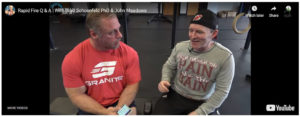If there is one aspect of weight training that has been addressed multitudes of times in the blog articles and books on this website, it could be summed up with the following statement:
One of the biggest keys to consistent strength gains is to train with precision in terms of training hard enough without training too hard.
If you don’t train hard enough, your body has no reason to change by gaining strength because your body can handle the training stress in its current condition. In contrast, if you train too hard by using too much weight, too many sets, and too many reps, your body will become overwhelmed with the training stress you are putting on it. Why would your body want to gain strength and allow you to use even more weight, sets, and reps, when it’s overwhelmed with the amount of weight, sets and reps that you are already using? It wouldn’t.
I could put it another way:
Perhaps the biggest mistake in weight training is to either train to hard, or not hard enough.
I am not the only one who believes this. Listen to the following interview with Dr. Brad Schoenfeld, a researcher on the science of gaining strength and muscle size.
Brad Schoenfeld Interview
Be In Tune With Your Body
Dr. Schoenfeld goes on to say that you must be in tune with your body in order to determine if you are training with the right amount of volume and intensity. He also explains that it is an individual matter as there are individual differences in regard to how much volume and intensity are best for each lifter.
The Starting Place: Training Thresholds
When it comes to knowing how hard and how much to train, I believe the starting place is the use of training thresholds. I often refer to these thresholds as “precision points.”
The Rep Speed Threshold
The first training threshold to be aware of is the rep speed threshold which means that you should be aware of how long you can maintain a steady even rep pace when lifting within a set. I recommend that you stop a set after reaching either your limit rep or your marker rep. Your limit rep is determined by the limit of reps that you can perform while maintaining a steady even rep pace. Your marker rep is the next rep after the limit rep, which means it is the first rep that starts to slow down after you can no longer maintain a steady even rep pace.
The Peak Strength Threshold
A second training threshold is based on how many sets you can repeat before you begin to weaken and can no longer perform as many reps as you normally can with the amount of weight you are using. I sometimes refer to this as the peak strength thresholds as the concept is to repeat sets for a muscle group as long as you are at peak strength during a workout. Stop when your strength drops.
If you stick with these guidelines, you can always adjust the intensity and volume upward or downward to see if it works better. From my own personal point of view, the use of the training thresholds discussed in this article is the most consistent, predictable, way to ensure that I am training hard enough without training too hard.
Find The Right Training Frequency
The next step is to find a training frequency that works. The optimum training frequency can vary according to how hard and how much your training. If you use training thresholds, you won’t be pushing your sets to failure, nor is it likely that you will be performing tons of sets as most people do not have the capacity to perform tons of sets while remaining at full strength. Since you are forced to limit the intensity and volume when following the guidelines for training thresholds, you may find that you can train more often without overtraining.
What is the single biggest mistake in weight training? It basically comes down to training too hard, or not hard enough. If you are not making progress, ask yourself if you are making this mistake. If your answer to this question brings you to the conclusion that you are either training too hard, or not hard enough, make adjustments as necessary until you find the sweet spot in terms of the right amount of intensity, volume, and frequency. Best of training to you.

